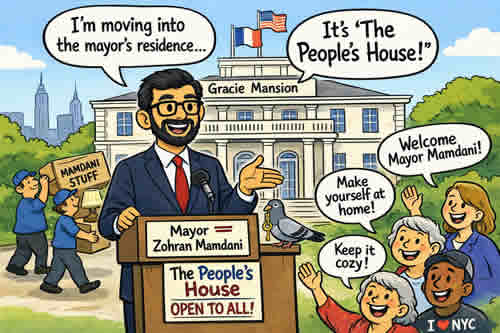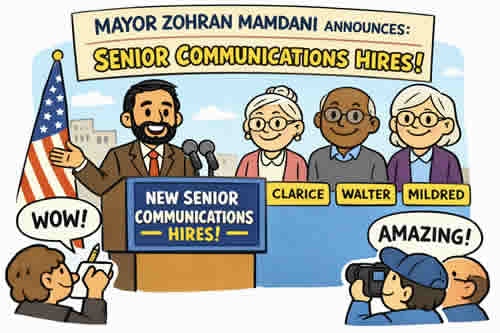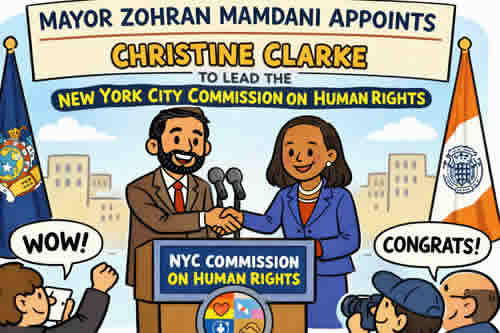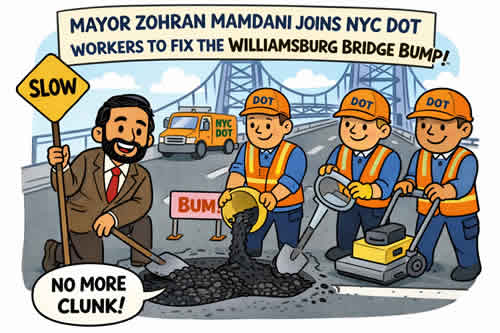Jul 7, 2023
Deputy Mayor Philip Banks, Public Safety: Good afternoon and welcome all. They got a picture that says, “Look here.” Right, right. That’s specifically for me, right? Okay. Okay. So listen here. Thank you for tuning in. We are joined here today by the New York City’s chief medical examiner, Dr. Jason Graham, whose office has hit historical milestones for turnaround times in its analysis of gun crime evidence. And this is going to have a very long-lasting effect as the city is seeing a decline in shootings and then the decline in violent crime and, in no small part, you had a very big part about that. So we’re very interested in the long-lasting impact that that’s going to have.
We’re also joined, I believe for the first time, Department of Probation Commissioner Juanita Holmes, who’s here to provide an overview for us on what the Department of Probation does, some of its programming services, and its role in the criminal justice system in public safety. And if it’s not her first time here, I believe it’s certainly her first time as the commissioner of probation.
And then we have NYPD Chief of Transit, Michael Kemper, who will be discussing the very alarming trend of subway surfing. And we need to sound the alarm to keep our teens and our kids safe. So for those of you who are joining for the first time, these public safety briefings are designed to let you hear information directly from the administration, right? So you can hear directly from us and we can hear directly from you on what we are doing to keep you safe, what we need for you to do to help us keep you safe, and how we are going to work on this together. So each briefing features different speakers, agencies, and topics, such as, breaking news or new initiatives like today’s update from the chief medical examiner or an inside at a particular agency, like you’re going to hear an overview from Chief Commissioner Holmes. And information on tips and things you can do to protect your loved ones, like our discussion today on subway surfing.
So if you would like to stay informed of upcoming public safety briefings, please visit hearfromeric.com and sign up to receive emails from Mayor Adams. You sign up, we will let you know a few days in advance what we are discussing so you can formulate your questions and certainly it’s a two-way reply. You communicate with us about some of the areas that you want us to concentrate in, and we will do our best to do that.
So let’s talk about OCMA. Combating gun violence from all fronts is one of the mayor’s top priorities, he has campaigned on public safety, he is speaking about gun violence. You cannot keep a city safe, or more importantly, you can’t have a city feel safe unless you at first take the turn in keeping gun violence down.
And we have seen very positive results this year about what the city is doing and the trend when it comes down to gun violence. But by no stretch of the imagination, I don’t want everybody to feel overly comfortable, this is something that you have to continually to push, to push, to push. And a lot of people, specifically the people up here, know this as well, there’s no putting up a flag. This is something we have to do consistently. When bullets fly, right? They don’t turn back in and they don’t turn around, so we have to make sure that gun violence is something that we as a city stay on top of at all times.
So at the beginning of 2022, the mayor asked the office of public safety to survey all of the different agencies across the city to see where investments could be made to crack down on gun crimes and ensure existing gun cases were handled efficiently. And one of the solutions that we and the medical examiners came up with was to create a dedicated DNA crime unit, the first of its kind in the United States. The unit was formed recently. It’s already hitting record processing times and processing gun crime evidence. And I’d like to turn it over to you, doctor, to let the public know exactly what this is and what can we expect.
Dr. Jason Graham, Chief Medical Examiner: Well, thank you very much. Deputy Mayor Banks, we really appreciate your support in making this a reality, making the DNA Gun Crimes Unit possible. Good afternoon to New Yorkers. Before I tell you more about the new DNA Gun Crimes Unit and what it means for public safety, I want to share a little bit about basic information about the agency that I lead. The city’s Office of Chief Medical Examiner, or the OCME. OCME plays an important role at the intersection of public health and public safety in New York City. Established in 1918, we’re the largest agency of our kind in the country. Our doctors, scientists, and other professionals worked 24/7, 365 to investigate deaths, operate world-class forensic laboratories, and respond to multi-fatality incidents, ranging from the World Trade Center to the Covid-19 pandemic.
New Yorkers may be most familiar with our work in death investigation. When someone dies in sudden or traumatic circumstances, our medical examiners, doctors, who are trained in the medical subspecialty of forensic pathology, determine the cause and manner of death to bring impartial answers for families and, if applicable, for the criminal justice system. These findings can also inform public health policy and help leaders plan and make decisions that save lives. We’re very proud that our in-house training program has produced about 20 percent of the board certified forensic pathologists in the country. Ensuring that New York City remains covered with this critical service despite a national shortage of medical examiners. Among medical examiners offices, the OCME is unique in our engagement with families who’ve experienced loss. It’s part of our agency’s culture. We hope your family never suffers the kind of tragedy that calls for the OCME’s involvement. But if the worst should happen, please do know that we’re always here for you.
Our impartial investigations are supported by advanced resources, including the Forensic Toxicology Laboratory, which analyzes postmortem samples for the presence of drugs and other toxic substances. The oldest lab of its kind in the country, it works to stay on top of the fentanyl driven overdose crisis that’s touched so many families in our city. And of course, OCME operates the city’s only DNA laboratory, the largest public crime laboratory in North America. Staffed by nearly 200 forensic scientists, the lab analyzes thousands of items of evidence every year from all categories of crime in New York City, including homicides, sexual assaults, and property crimes. The results of our testing can be used to convict the guilty and exonerate the innocent. Last year, with the support of the Adams administration, as the deputy mayor mentioned, OCME established the DNA Gun Crimes Unit in our forensic biology laboratory, the first of its kind in the country.
This unit is dedicated exclusively to the analysis of evidence from gun crimes to ensure that accurate and impartial results are delivered to the criminal justice system absolutely as swiftly as possible. When we established the gun crimes unit, we set an ambitious goal of a 30 day or less turnaround time for DNA testing and evidence. Within one year, we’ve achieved that goal. As we announced at OCME with the mayor last week, our turnaround time now stands at under 30 days, the fastest of any big city lab in the country. Meaning that stakeholders in the criminal justice system have reports within 30 days. With this unprecedented turnaround time, the OCME is doing our part as scientists to allow the criminal justice system to resolve cases as quickly as possible. By providing prompt, accurate, and impartial results to help convict the guilty and exonerate the innocent, OCME is contributing to a safer New York City for everyone.
This work is also made possible by the dedicated scientists of our DNA Gun Crimes Unit, including 24 new forensic scientists all hired and trained within the past year. And I want to acknowledge these New Yorkers for stepping up and answering the call to serve their communities through forensic science. As I’ve shared with you today, OCME stands uniquely at the crossroads of public health and public safety in New York City. The DNA Gun Crimes Unit is the latest chapter in our long and ongoing mission of science serving justice. We’re honored to do this work on behalf of New Yorkers during some of the very most difficult times in their lives. Thank you.
Deputy Mayor Banks: Thank you. Hey Doctor, thank you very much. So a couple questions that I have. Prior to this investment at your lead, because of what you did with this unit, I think I came to see the lab early in the administration, right?
Dr. Graham: Yes.
Deputy Mayor Banks: And you gave me a fantastic tour and, at some point, we probably need to do a tour there where we could actually maybe do one of the briefings actually there to actually show the dedicated work that you do. Because I think when people see, it’s actually fascinating. But prior to this unit, you said that the turnaround time was 60 days, correct?
Dr. Graham: It was just under 60 days before we kicked off and established the gun crimes unit. Yep.
Deputy Mayor Banks: And what’s the national average?
Dr. Graham: Well, we were just under 60 days and, at that stage, our turnaround time for these types of cases for gun crimes cases was better than 90 percent of the rest of the country. So we were starting from a very good place. We’ve cut that turnaround time in half now to under 30 days, which is unprecedented.
Deputy Mayor Banks: Okay. And see, I think that’s the point that I like to get out. New York City was better than 15… And I didn’t say the administration, New York City, the gun lab, because it belongs to all of us, we were better than 95 percent of the people labs in the country and yet that wasn’t enough. And we push and push and put additional investment on. Now we are approximately 30 days, correct?
Dr. Graham: That’s right.
Deputy Mayor Banks: And just out there, that 30 days, that gun gets into the lab and you said two key points that I want to focus on. One, we have the science based evidence to determine was this gun in the hands of the shooter or was it not? Because there’s some people, we want to make sure that if in fact you were not the person who committed this particular crime, he’s actually providing evidence for that as well, and I think that’s the point that sometimes gets missed.
But between that 30 days and that 60 days, violence doesn’t stop and people continue to get shot and you save and your people save a lot of lives by cutting it down from 59 days to 30 days. I don’t want to clap and say [inaudible] because I’d like to get it to 29 days and 28 days and 27 days. I’d like to continue to push to get it down to the minimum amount of time that’s necessary, but I certainly have to salute you.
When we discussed, we asked, “What did you need?” You said exactly what you needed. You had the whole thing laid out, the investment was made and you’ve actually carried this. So I appreciate that, and I’ll just say that lives are being saved because of the efforts of you and your particular team that takes place there. So Doc, thank you very much.
Dr. Graham: Thank you very much.
Deputy Mayor Banks: So next up we have Juanita Holmes, commissioner of the Department of Probation. She was appointed that role to the mayor in March of this year, but she is certainly no stranger to city government. Commissioner Holmes has dedicated more than three decades to protecting the public. She worked in the NYPD. She was a precinct commander. She was a borough commander. She was a chief of patrol, which means all uniformed forces reported to her. She was the chief of training. She worked in domestic violence. So she has a very, very storied career and a lot of different history. The mayor has decided to take her expertise, move it over to the Department of Probation, and now, the commissioner here is going to be able to just give us an explanation on exactly what does probation do, what are some of the critical work of probation officers. So good seeing you, Juanita.
Commissioner Juanita Holmes, Department of Probation: Great seeing you as well. Thank you, deputy mayor. Good afternoon, everyone. Good afternoon to our virtual community. So I’ll talk a little bit about the great work done by the men and women in the Department of Probation. The Department of Probation is dedicated to enhancing public safety, reducing recidivism by providing individual under our jurisdiction with effective and individualized supervision, support opportunities for personal growth. We strive to empower those we serve fostering positive change and helping them become law-abiding citizens.
Through the collaboration with city agencies, departments, community partners, stakeholders and justice involved individuals, we seek to create a future ensuring everyone receives the services they deserve and remain on the right track so that they can live a productive life.
Just to go into a little bit about probation, because I know sometimes, it’s quite often confused with parole. Probation is actually an alternative to incarceration where parole, you’re actually incarcerated and then released for good behavior or different variable aspects. With probation, it’s actually determined that you can actually be on community supervision, community corrections. Therefore, you’re actually out in the community. So it is very important for probation officers to get it right with our assessments, how often that we are visiting you, what programs that we are providing you with, what services you’re being provided with. And as a result of such, I think they do a very good job considering the population that we are met with. Most people don’t know over 34,000 in individuals came through probation for the calendar year of 2022. 16,000 resulted under supervision, a naturally smaller population with the juvenile operations. They consisted probably of 7 percent. The remaining 93 percent was the adult population.
I know there’s sometimes an interest in raise the age. In 2018 and 2019, raise the age was implemented as a result of such. We have an increase in juveniles naturally and a decrease in adult population. But contrary to what some people may believe, we technically only have probably about 200 or somewhat individuals incarcerated partly with adult… I’m sorry, not incarcerated. The adult population consists of 132 individuals that are actually being supervised that fall between the age of 16 to 18. The juvenile population is 463, but the raise the age component is 111. Out of those 111, twenty four, actually I apologize, 24 percent actually committed a offense or some sort of offense for criminal possession of a weapon.
Deputy Mayor Banks: So let me just try to understand this for the audience here. Talk about assessments. So your officers go out, they have a client. They go out there, they do an assessment, and then they link in that person with services. Tell me how that works.
Commissioner Holmes: Right. So what happens, there’s a process. So for juveniles, a little more technical, naturally, babies. So they come through what we call intake. A smaller population. When they come through intake and assessments made whether or not they should receive some sort of adjustment, which is a diversion program. So they never see the criminal justice pipeline. Past that, it may be determined that we’ll give it to a judge to decide. Now, it’s forwarded to the law department who takes a look at the assessment that’s conducted by the probation officer. And then determinations as far as supervision or sentencing is made at that point.
An adult population technically, the judge determines whether or not that they’re going to be sentenced, convicted, and then there’s a determination made whether or not they’re going to be placed on probation or they’re going to be incarcerated. If they’re placed on probation, they then come to us. At that point, we do what’s called a investigation. So we look at the individual, we look at family support, we look at whether they’re married, if they completed school, if they’re unemployed, if they’re truant. All of these things are taken into consideration for our clients to make sure that we give them the best possible assessment that we possibly can.
Deputy Mayor Banks: Now, I want the audience to know a little bit about the NeON centers, which is a big thing. So can we just get a briefing on what exactly is a NeON center?
Commissioner Holmes: Yeah. So the NeON centers are very dear to me. They are actually spaces for our clients. We realized sometimes, it’s difficult for clients to travel to the courthouses or to a probation officer to check in and also uncomfortable. So as a result of such, these spaces were put throughout every borough in New York City. Also involving a lot of community input, which they are our stakeholders, NeONs, believe it or not, are where we deliver messages such as credible messengers, which is anti-violence that they’re speaking to the individual clients about. It’s where we prep them for job readiness. We have clothing. They may need a tie or a shirt. They may not know how to fill out a resume. Also now, we have what’s called NeON Plus, and very dear to my heart. A lot of people don’t have bare medical healthcare in order to go and just have a simple checkup.
So they’ll be able to sign up for Medicaid. They’ll be able to sign up for certain aspects of work. We have a contract now for CDLs. Everyone knows driving trucks is major now with Amazon and all these other delivery venues that we have. So recently, we just were very successful in signing up someone that trains them how to drive buses, dump trucks, things of that nature.
Want some real tangible careers for our clients, especially the adult population, which accounts for 83 percent. Men over the age of 24 account for 83 percent of probation’s community. It’s essential to me as well as to the Department of Probation and to our clients that we try and give them the best possible outcomes we can provide them with. And I always say people need money. So jobs are—
Deputy Mayor Banks: So [inaudible] says we could describe this as like a center. You said a space. That’s very interesting where there’s multiple services in one place that can be provided to them to help them get or maintain on track.
Commissioner Holmes: Absolutely, and it’s also a space for the general public. So we have food pantries. We’re going to start doing a better job at marketing this because believe it or not, I was with PD and didn’t know a NeON exists. So as a result of such, I think it’s very important, especially in the Bronx, one of our most successful, largest food pantries where anyone can come in from the community and actually get food. Anyone can come in from the community and actually get clothing if they want to go for a job interview, if they simply just need a coat because they’re met with inclement weather. So there are spaces. They provide services, programs are delivered there. And something as simple as just come and do your homework. Sometimes, young people especially just need a safe place.
Deputy Mayor Banks: It’s just for all too much in society that incarceration is not the only tool that you need to have in the toolbox. There’s services that there’s a lot of these individuals who are either on the cusp of criminality or have actually crossed the line. And if you give them the proper services that they need, and as you pointed out, helping get them the help with the GED, job training, we can actually correct a lot of different individuals without incarcerating them. So a society needs to have and the city needs to have, a full system. In fact, there are some that need to be incarcerated, but I do believe that there’s a large, large, many of them that if we catch them at the right time, do the proper assessment, and give them the services they need, that we can actually keep them out of the criminal justice system and have them productive. And I can’t think of anybody that’s more qualified than you to do that particular job. I’ve known you a long time, I’ve worked you a long time. I know how you feel, especially about these youth out there. So I just want to salute you for the job that you’re doing and please keep up the good work.
Deputy Mayor Banks: So last but not least, we are joined by the NYPD chief of transit, Michael Kemper, who along with the man, other members of the administration, has been sounding the alarm about the dangers of subway surfing.
I want to say, I just don’t understand subway surfing and it’s been a long time since I’ve been young. I don’t remember doing it and I’m not going to judge these individuals that are doing it and the reason why they’re doing it, right. People do things for different reasons. I’m not going to judge them. I just hope that they stop it. It is extremely, extremely dangerous. And I want to say, I didn’t do anything as silly as that when I was younger, but my memory fail me. I probably did. But it is something that we need to get the message out, that is something that we need to find other ways to be able to quench whatever thirst that you have for this type of act. And Mike, we need to continue to sound the alarm. So tell us about subway surfing and what needs to be done about that.
Michael Kemper, Chief of Transit, Police Department: Sure. Good afternoon, and thank you Deputy Mayor Banks for allowing me to join you today to speak on a subject that is incredibly important, message that all New Yorkers need to hear. The New York City subway system is a vast, complex and impressive system. It’s truly the lifeblood of our city. It connects communities. It’s a way to explore this great city of ours. And most importantly, it’s a means of transport. Again, it’s a means of transport, but what we’ve seen is some of our riders, mostly of young age are treating the subway system like it’s a playground and are participating in an extremely dangerous act, subway surfing. And unfortunately, we’ve witnessed far too many tragic outcomes associated with this senseless act, which is fueled by social media, intention, clout, and poor decisions. What makes it even worse is that what we are experiencing is entirely avoidable.
The NYPD is fully engaged in efforts to end this dangerous trend to protect participants who are not thinking of the tragic consequences and devastation associated with it. Our efforts include intelligence gathering, investigations, deployment, enforcement which includes arrests and outreach. This year alone in six months, we’ve recorded six incidents of subway surfing in New York City that resulted in tragic outcomes. It was during these incidents that four teenagers lost their lives and three teenagers suffered some very serious debilitating injuries, injuries to be quite frank, that are devastating and life altering, and injuries and death that has left families and friends, heartbroken and shattered. The ages of the four individuals who lost their lives are as follows: 16, 15, 14, and 14. It should be known that these are the exact ages that the majority of the kids we’re encountering who subway surf. Young, immature, and impressionable kids who are not thinking of tragic consequences and are only thinking of in the moment and they’re thinking of attention and popularity.
Our deployment, our investigations and our enforcement efforts this year have already led to countless occasions where we’ve deterred people from subway surfing as well as dozens of apprehensions and over 70 arrests. Yes, subway surfing is illegal, and if you’re caught, you will be arrested. We have also identified dozens of subway surfers and have made and will continue to conduct home visits to their parents and guardians to let them know that their family member and loved one participates in this deadly act and to explain to them the dangers associated with it. We are also working alongside our partners at the New York City Department of Education, our educators, so that they can incorporate prevention lessons and speak to their students about this dangerous topic. Additionally, we continuously speak about this topic in public forums, forums such as this, as well as on our social media platforms where public service messages are displayed. Matter of fact, a public service message was developed and we just released it this week on this topic. So if we may, could we view that PSA.
[PSA Plays]
Chief Kemper: Our aim or our goal is focused on prevention and safety, all to avoid unnecessary tragedy. Our message is clear to anyone who’s considering subway surfing. Don’t do it. Not only is it illegal and you will be arrested if caught, but people are literally dying while doing it. The subway system is an unforgiving place and one slip, one misjudgment or one false move, while that is usually followed with life altering or life-ending outcomes, there are no do-overs. No amount of likes or comments from your friends is worth the devastation you will bring yourself and to your family. And a message to anyone who sees anyone subway surfing, please call 911 immediately to report that. Your call just may be saving a life. And finally, the message to our parents, guardians and family members, speak to your children and family member, then speak to them again, then speak to them until you sound like a broken record. Because the subject of stopping subway surfing, merits repeating and can literally save the life of your loved one. Thank you.
Deputy Mayor Banks: So Mike, we got that right. And even if you don’t have kids, right, grandkids, your niece, nephews, neighbors, we all just tell one person, this is something that we just can’t do, we are better than this as a city to stop, we’d have an impact. But what happens if you’re riding the trains and you see kids doing it or about to do it? What’s the message to an individual? What do you want that individual to do?
Chief Kemper: So, great question. And that’s a question we get a lot surrounding this topic. You got to report it immediately. And there’s many, many different ways. If you’re riding a train, there’s many ways that you can report it. If you’re on a platform, if you’re street level and you see kids on top of a train, subway surfing, we want that reported to us immediately. We want to stop that train and take these kids off the train. You can call 911. Again, that’s an emergency. People are losing their lives. If you’re on the train, let the conductor know immediately. The conductor has full control of the train and he can stop it safely and call us to take these kids off. So again, the goal is prevention. The goal is to report it. If the public sees it, anyone listening to me right now, report it immediately. Treat it as an emergency and also talk to your children. Talk to your loved ones about the dangers associated with it.
Deputy Mayor Banks: So that’s a direct message. Talk to someone today, tomorrow, the next day about subway surfing. If you’re actually on the trains, call 911. Get to the conductor, let the conductor know what you’re seeing because we can actually stop that. So Mike, I appreciate that. And in closing, just before we go to question, just want to say, we just passed July 4th. I don’t like to talk about statistics because… And my colleagues up here in the NYPD may concur, is that you go to these meetings and you talk about your down in shooting or your down in robberies. It does nothing for the person who was robbed. So there’s nothing for the person who was a victim, right? So you’re very seldom ever hear me talk about statistics other than as indicators to be able to shift strategies. But we had a very relatively safe July 4th as July 4th go, where we generally have a lot of difficult conditions.
We’re starting to see a lot of positive indicators that are taking place when it comes to violence in this particular city. We’re still grappling with some GLA issues. And I think you’re going to see the NYPD making announcement real soon about that. But as the city together, we can continue to push this city down and down and down. And what’s success? When we have no crimes. And people say that can’t happen. It may not happen, but it doesn’t mean we can’t continue to try that. And part of that, what the mayor’s doing is trying to break down silos. He’s trying to get all the agencies to work together. What we are asking for you is to push us, for the people in the community and these neighborhoods. We’re trying to tell you exactly what we are doing. We’re asking for you to tell us what you see and what you suggest that we take place, and as a city we can actually work this. So that while we are heading in the right directions, all of the indicators are well, we’ll never rest on our laurels because if one person is shot or one person is a victim of a sexual assault, if one person is a victim of domestic violence, it is too many times that it’s happening.
We want to be able to make sure as a city that we avoid any of the avoidable crimes that we can take here. So it’s not easy, but nothing that’s worth it is easy. To everybody out there, I certainly thank you for the people who do contribute to helping us and we are going to continue to try to get better and more effective as much as we possibly can. So Derek, I’m done turning over to you.
Moderator: Thank you deputy mayor. We will now take any on-topic questions from the media. If folks have any questions.
Deputy Mayor Banks: Love the media.
Moderator: Great, thank you. Earlier this week the administration reached out to New Yorkers asking them to submit questions for the officials that have joined us here today. We will now get to as many of those as we can with the amount of time that we have left. Our first question comes for Chief Kemper from Tariq in Manhattan who asks, would it be possible to have sensors or cameras on top of trains alerting the conductor that an unauthorized person is moving on top of the train?
Chief Kemper: I think, Tariq, that’s a great question. That’s a question that we speak to our partners at the MTA a lot about, as most recently as this week. So let me say this, the NYPD and the MTA, we’ve recognized the seriousness of this topic. The MTA, and again I could say this with certainty, they are in discussions and they’re brainstorming, if you will, and they’re thinking about different mechanisms that they can use to prevent and detect and identify subway surfing. I’m sure the MTA in the near future will have more to say on that topic. I hope I answered your question, but the topic of sensors is a topic that, Tariq, I personally asked that question to MTA leadership in recent past, so great question.
Deputy Mayor Banks: Is it a great question because you asked it prior to that or was it a great question?
Chief Kemper: It’s a great question because it’s a great question.
Deputy Mayor Banks: Okay, can you just make sure the MTA chair knows that the question came up? Even though he may be aware, I just want to make sure that you hit it again saying it’s not only coming from you, but people in the community are asking for it as well.
Chief Kemper: 100 percent, will do.
Deputy Mayor Banks: It was a good question. It was a good question.
Moderator: Thank you Chief. The next question comes for Commissioner Holmes from Jessica in Manhattan who asks, how do the ranks of officers work within the Department of Probation? Is it similar to the ranks in the NYPD?
Commissioner Holmes: Very simple, it’s structured like a line organization, just like NYPD. You have subordinates and you have supervisors, so just different titles.
Moderator: Thank you. Next question comes from Alfred in Queens for OCME, who asks, how does a gun crime lab help when it comes to a criminal investigation?
Dr. Graham: Well, thank you for that question. Good question. Crime scenes have a number of different types of evidence. Some of that evidence is evaluated by the NYPD crime lab. We at the medical examiner’s office operate the city’s forensic DNA laboratory. And the type of evidence we evaluate could come in the form of something that’s seen as evidence at a crime scene like a blood stain, or it could be something that can’t be seen with the naked eye, like DNA evidence left from the touch of a suspect’s hand on the trigger or the handle of a gun. The DNA that’s left behind by a suspect at a crime scene can only be detected by the work that we do in our lab. The DNA left on the trigger or the handle of a gun used in a crime can only be linked to a suspect through the testing that we do.
So in our lab, this work helps identify potential suspects now much faster than ever. Again, work that can be used to convict the guilty or exonerate someone who’s innocent of a crime.
Moderator: Thank you. The next question is for the NYPD from Ben in Manhattan who asks, is the NYPD continuing to have officers in the subway system?
Chief Kemper: Ben, another good question. The answer is yes. Look, Mayor Adams and this administration has been clear from day one, public safety is their top priority. That certainly includes public safety in the subway system. Between Mayor Adams Subway Safety plan that was released in February of 2022, followed by the Cops, Cameras, and Care program, that really initiated in October, tremendous investments have been made to public safety in the subway system. Those investments include the infusion, if you will, of a large, large amount of police officers, additional police officers patrolling the subway system. So as we’re sitting here right now, we are deploying upwards of 1,000 additional uniformed cops to the subway system every day. These cops are assigned to a host of different assignments, train patrols they’re doing, they’re assigned to platform patrols, mezzanine patrols and fixed at turnstiles. New York City cops are the greatest cops in the world.
I want to take this opportunity to recognize them and thank them for the work they do each and every day, because what they do each and every day, I see, and it’s incredible. It’s because of the work they do that… Last year in October before this investment really kicked in New York City, crime was up over 40 percent in the New York City subway system. But because of this infusion, but more importantly, you could have a plan, but without the men and women getting their job done, what good is that plan? But because of the cops, crime not only leveled, stopped immediately, but we went from a 45-plus percent increase in crime to a decrease in crime. Looking at the first six months of this year, calendar year 2023, we’re about 5 percent under in crime versus last year. We’re also lower crime for the first six months versus pre-pandemic years also.
Again, that didn’t just happen. All enforcement efforts are up in the subway system. Arrests are up dramatically this year versus prior years, including pre-pandemic. Summons for quality of life offenses up dramatically, [inaudible] that includes all quality of life violations. Our fare evasion enforcement, a key component to our crime reduction strategy up tens of thousands in the first six months. Weapons possessions arrests are up dramatically. Knife possession in the subway system up 60 percent this year versus last year. Listen, I could talk about what the men and women are doing in the subway system and I could talk about the results they’re having, because they’re really having very, very good results. But just to jump on what Deputy Mayor Banks said, one crime is one too many and we really, really recognize what does that mean to the person that was victimized of a crime.
And we do recognize that we still have a lot of work to do. We are not naive, right? A person, a rider, deserves to enter the New York City subway system, travel from point A to point B in peace and not become victim of a crime. Probably equally as important or more importantly, they should feel safe. They should feel safe doing it. Those are the challenges that we face policing the subway system. But here’s what I can tell you and here’s what I said already, New York City is blessed with the greatest cops in the world that each and every day come in to help, and that’s what we do. So I think, Ben, I hope I answered your question. I gave you a little more than you asked for. The answer is yes.
Moderator: Great, and our final question comes from Darlene in Manhattan for Commissioner Holmes who asks, does the Department of Probation offer anti-violence or job readiness programs?
Commissioner Holmes: Oh, absolutely. So laser focus when it comes to those two areas. Naturally to anti-violence, we actually have credible messengers actually that are hired that operate out our NeON spaces speaking to individuals every day. We have external as well as internal job readiness. We work with the Fortune Society, the Osborne Foundation, Strive. Internally, naturally, we have NeON Works, which functions operates out of our NeON space. We also have Youth Wrap, and then we have young adult programs.
More at NYC.gov New York City Hall Mayor Office News – Big New York news BigNY
– Midtown Tribune New York news –










